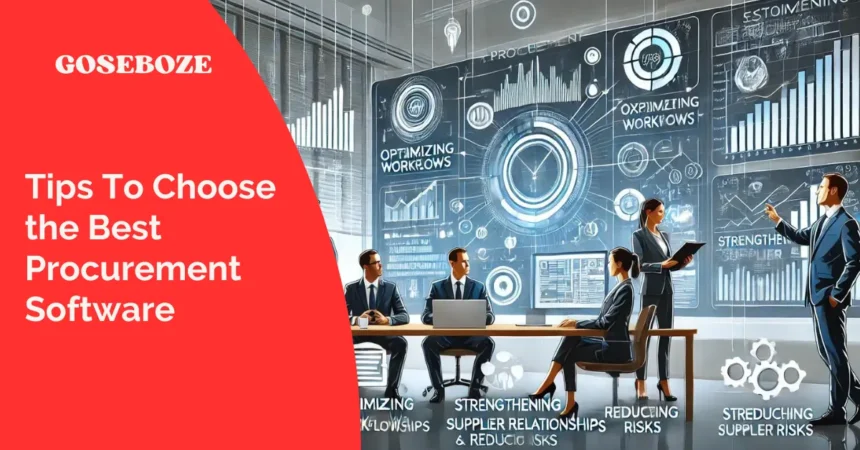For companies trying to increase productivity and optimize their purchasing procedures, choosing the appropriate procurement software is essential. This guide examines important aspects to take into account when selecting procurement software, such as determining organizational requirements, optimizing workflows, strengthening supplier relationships, obtaining insightful knowledge, and reducing risks. By concentrating on these elements, businesses can find a solution that not only satisfies their immediate needs but also promotes long-term strategic objectives and adaptability in the dynamic business environment.
- Determining Your Procurement Needs
When it comes to procurement software solutions, there is no better way to go about it than to understand your needs. Identify functionality needs from the current processes and existing or potential issues. Some of the things to evaluate include the differences between on-premises and SaaS implementation, the extent of flexibility needed, the size of the business and corresponding need for flexibility, and how well the solution can integrate with other business systems. Engaging these main stakeholders is vital to guarantee that the software is able to meet the needs of all the end consumers.
This being an acknowledgment of the fact that no software is universal to all organizations, a needs assessment gives direction on what basic functionalities an organization cannot do without. This helps stop wastage of money on unutilised capacities where one can overspend or underspend. By having a better understanding of procurement operations and the organization’s strategic goals, one can avoid being distracted by options that are not relevant or beneficial.
- Streamlining Processes
Once these decision factors are defined, the central benefit to consider is the impact of the procurement platform on source to contract. Essential repeated paper-based business processes are streamlined by powerful software. Other effective and efficient solution, such as full requisitioning and purchase order generation, Approvals, easy to use and well constructed databases that help in managing vendors and contracts and complete reporting systems, help in improving the overall process.
Read Also: How to Choose the Right Technology Stack for Your Startup: A Guide for Founders
As a result of automating the processes, work is reduced and the effects of the bottleneck and delay, which are associated with paper works, are eliminated. This acceleration offers a handy way for employees and other stakeholders to receive important information through procurement process transparency. This further enhances the procurement velocity with features such as system alert and notification to inform the users of actions awaiting them.
Preventing these vices, automation lowers overhead expenses that arise due to concealed and lack of accountability. Due to the enforcement of the process, there is likely to be low incidence of delay, dispute or non-standard purchases that are outside the agreed best practice. Procurement can be transformed from strenuous manual task to a strategic tool for organizations through automated workflows.
- Enhancing Supplier Relationships
Besides, internal organizational workflow is not the only way that advanced software increases productivity; it also enhances the supplier relationship management. Having a central list of potential vendors and preferred suppliers guarantee the identification of partners with compliance to organizational standards and other desired commercial terms. Since the system encompasses all supplier interactions and allows decision-making for actions that will be in the best interest of the business, the focus goes beyond price.
Self-service and eProcurement also reduce bureaucratic work for both focal cheap suppliers and allow them to direct less attention to suboptimal tactics. Other digital touchpoints that provide up-to-date order status, consolidated shipment tracking, and more outside of a company also improves external experience and ownership. When the software runs compliance checks for selection of preferred partners and price validation, the buyers do not engage as much at the transactional level and devote their efforts to working with suppliers on value enhancement activities.
Enterprise coordination is also enhanced by choosing the most effective vendor partners out of a pool of qualified vendors by evaluating the quality of goods and services to be offered as well as the agreed prices to the enterprise. It indicates that the optimum external resources are worked collectively by the employees when they adopt the standardized tools of procurement to the maximum level.
- Gaining Valuable Insights
An efficient s2c solution also provides procurement with the visibility and easy access to such information through analytics and reporting tools integrated into the solution. Each of the main operations is also evaluated and analysed with regard to a set of key procurement metrics which track performance and spending patterns. Some of them are cycle time, time to build the work in progress, time to report the delay, deviation from the preferred agreements by category and business group, and spending by the vendor or by the commodity code.
It is at this level that real-time operational insight is obtainable, and decisions regarding purchasing are made based on the data available. Maybe buyer usage patterns show further cost savings that come with the aggregation of spending with key suppliers or opting for cheaper goods and services. It also gives a clear indication of the ROI for the software itself where it becomes easy to quantify the tangible and intangible benefits accruing from the software after its installation.
- Mitigating Risk
S2C solutions also address the underlying risks associated with decentralization of process activities in procurement. This is the view held when maverick spend, which avoids agreements with preferred suppliers, undermines potential savings. Non-contract spending also poses the organization to some risks for they provide little control over the quality of products being used, the insurance cover, and overall, the total dollar being spent outside the contractual channels.
These exposures are reduced by the strong software that supports automatic routing of procurement activities that have business rules and approval chains well configured. This way, robotic measures guarantee the transaction flows through the correct channels with the right supervision. Eliminating the use of unauthorized suppliers helps reduce the risk of receiving low-quality materials, works, or services that are not up to the company’s specifications.
Conclusion
In its simplest terms, vendor management system always revolves around one of these four initiatives: cost reduction, risk management, creation of efficiency, and gaining insights. But perhaps most important of all, is flexibility and security of mind such a right solution affords. It is the companies that intensify their activities aimed at choosing software that meets the needs of an organization to get a system that provides procurement with an opportunity for acting as a significant business function. They also ensure the staining value relations for consistent change are secured hence the need for constant staining.

Morgan Reid, with an MBA and a decade in business strategy, specializes in boosting company performance and operational efficiency. Known for practical insights, Morgan contributes to publications and speaks at industry events, blending expertise with a passion for tech and business innovation.







